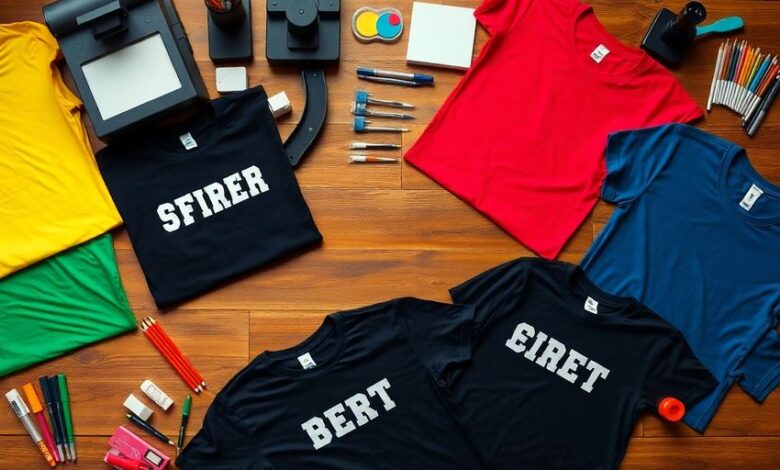Essential Tips For Starting Your Own T-shirt Printing Business While At University

Starting a t-shirt printing business while you’re still in university can be a fun and rewarding way to express your creativity and earn some extra cash. With the right approach, you can turn your passion for design into a profitable venture. This article offers essential tips for starting your own t-shirt printing business while at university, covering everything from understanding the market to balancing your studies with your entrepreneurial goals.
Key Takeaways
- Identify your niche and target audience to stand out.
- Create a detailed business plan to guide your efforts.
- Invest in the right printing equipment and supplies.
- Keep a close eye on your costs to maintain profitability.
- Use social media and local events to market your brand effectively.
Understanding The T-shirt Printing Business
Starting a T-shirt printing business while at university can be a great way to make some extra money and gain valuable entrepreneurial experience. But before you jump in, it’s important to understand the ins and outs of the business. This section will cover key aspects to consider.
Defining Your Niche
What kind of T-shirts will you specialize in? Are you thinking about custom products for university clubs, or maybe focusing on unique designs for a specific hobby or interest group? Maybe you want to focus on sports shirts, using CAD-Cut Vinyl printing. Defining your niche helps you target your marketing efforts and stand out from the competition. It’s about finding a gap in the market or catering to a specific audience that isn’t already being served well.
- Consider what you’re passionate about.
- Research what’s already out there.
- Talk to potential customers to gauge interest.
Identifying Your Target Market
Who are you trying to sell to? Knowing your target market is super important. Are you aiming for students, faculty, alumni, or even the local community? Understanding their preferences, needs, and buying habits will inform your design choices, pricing strategy, and marketing efforts.
Think about where your target market spends their time, both online and offline. This will help you determine the best channels to reach them. For example, if you’re targeting students, social media and campus events might be good options.
Exploring Different Printing Techniques
There are several T-shirt printing techniques to choose from, each with its own advantages and disadvantages. Screen printing is a popular choice for large quantities, while heat transfer is better for smaller runs and more complex designs. Direct-to-garment (DTG) printing offers high-quality prints but can be more expensive. CAD-Cut Vinyl printing is great for sports shirts. Consider the cost, quality, and scalability of each technique before making a decision.
| Printing Technique | Pros | Cons |
|---|---|---|
| Screen Printing | Durable, cost-effective for large runs | Setup can be time-consuming and expensive |
| Heat Transfer | Good for small runs, complex designs | Less durable than screen printing |
| DTG | High-quality prints, no minimums | More expensive, best for simple designs |
Creating A Solid Business Plan
Starting a t-shirt printing business while at university is exciting, but it needs more than just enthusiasm. You need a solid business plan. Think of it as your roadmap to success, guiding you through the ups and downs of entrepreneurship. It’s not just about securing funding; it’s about understanding your market, managing your finances, and setting realistic goals. Let’s break down the key elements.
Key Components of Your Business Plan
Your business plan should cover all the important aspects of your venture. Here’s what to include:
- Executive Summary: A brief overview of your business concept, mission, and goals.
- Company Description: Details about your business structure, products/services, and competitive advantages.
- Market Analysis: Research on your target market, industry trends, and competition. Understanding your niche market is key.
- Organization and Management: Information about your team, management structure, and roles.
- Service or Product Line: Detailed descriptions of your t-shirt designs, printing techniques, and pricing strategy.
- Marketing and Sales Strategy: How you plan to promote and sell your t-shirts.
- Financial Projections: Forecasts of your revenue, expenses, and profitability.
- Funding Request (if applicable): How much funding you need and how you plan to use it.
Setting Short-Term and Long-Term Goals
Goals give you something to strive for and help you measure your progress. Short-term goals might include launching your online store, securing your first major order, or reaching a certain number of social media followers. Long-term goals could be expanding your product line, opening a physical store, or becoming a recognized brand in the university community. Make sure your goals are SMART:
- Specific
- Measurable
- Achievable
- Relevant
- Time-bound
Financial Projections and Budgeting
Understanding your finances is critical. You need to estimate your start-up costs, track your ongoing expenses, and project your revenue. Create a detailed budget that outlines your income and expenses. This will help you manage your cash flow and make informed decisions about pricing, marketing, and investments. Consider using spreadsheet software or accounting tools to keep track of your finances. Here’s a simple example of how you might structure your projected monthly budget:
| Expense | Estimated Cost |
|---|---|
| Supplies | $100 |
| Marketing | $50 |
| Website Hosting | $20 |
| Software | $30 |
| Total | $200 |
A well-thought-out business plan is more than just a document; it’s a tool that will help you stay focused, make informed decisions, and adapt to the challenges of running a business while balancing your university studies. It’s a living document that you should revisit and update regularly as your business evolves.
Essential Equipment For Your Business
Starting a T-shirt printing business at university means getting the right gear. It’s not just about the printer; it’s about everything that makes the process smooth and professional. Let’s break down what you’ll need.
Types of Printing Equipment
Okay, so first things first: the printing equipment itself. This is where you’ll probably spend the most money, so it’s important to choose wisely. Here are a few options:
- Screen Printing: This is a classic method, great for bulk orders and vibrant colors. You’ll need screens, squeegees, and a light table for exposing your designs.
- Direct-to-Garment (DTG): DTG printers are like inkjet printers for shirts. They’re good for complex designs and smaller orders, but the initial investment can be higher.
- Heat Press: A heat press is essential no matter which printing method you choose. It’s used to apply heat transfers, vinyl designs, and even cure DTG prints.
Don’t rush into buying the most expensive equipment right away. Start with what you can afford and upgrade as your business grows. Consider buying used equipment to save money, but make sure it’s in good working condition.
Supplies and Materials Needed
Beyond the big machines, you’ll need a bunch of smaller supplies to keep things running smoothly. Here’s a quick rundown:
- Inks: The type of ink you need will depend on your printing method. Plastisol inks are common for screen printing, while DTG printers use special water-based inks.
- T-shirts: Obviously! Source good quality, blank T-shirts in a variety of sizes and colors. Consider offering different fabric options like cotton, blends, and even organic cotton.
- Heat Transfer Vinyl (HTV): If you plan on doing any heat transfer designs, you’ll need HTV in various colors and finishes.
- Cleaning Supplies: Keep your equipment clean to ensure the best print quality and prolong its lifespan. You’ll need things like screen cleaner, platen cleaner, and general-purpose cleaner.
- Packaging Supplies: Boxes, compostable garment bags, tape, and labels are all important for shipping your finished products.
Setting Up Your Workspace
Your workspace is where the magic happens, so make sure it’s organized and efficient. Even if you’re working from a small space, you can still create a functional setup. Here are some things to consider:
- Adequate Space: You’ll need enough room for your printing equipment, supplies, and a workspace for designing and prepping shirts.
- Good Ventilation: Printing inks can release fumes, so make sure your workspace is well-ventilated. Consider using a fan or opening windows.
- Proper Lighting: Good lighting is essential for inspecting prints and ensuring quality control.
- Storage: Invest in shelves, bins, and other storage solutions to keep your supplies organized and easily accessible.
- Work Table: A sturdy work table is a must for prepping shirts, applying designs, and packaging orders.
It’s also a good idea to have a first-aid kit on hand, just in case. You’ll be working with equipment and chemicals, so safety should be a priority.
Managing Costs Effectively
Starting a t-shirt business while at university means being smart about money. It’s easy to get carried away with cool designs and fancy equipment, but keeping a close eye on your expenses is super important. Let’s break down how to manage those costs effectively.
Estimating Start-Up Costs
Figuring out how much money you need to get started is the first step. This isn’t just about the printing equipment; it’s everything from software to licenses. Make a detailed list of every single thing you need to buy or pay for before you can print your first shirt. Don’t forget things like your brand design (logo, website) and any legal fees. Here’s a quick rundown of common start-up costs:
- Printing equipment (screen printing setup, heat press, etc.)
- Software (design software, e-commerce platform)
- Supplies (shirts, ink, transfer paper)
- Marketing materials (business cards, flyers)
- Business licenses and permits
It’s a good idea to add a buffer to your initial estimate. Unexpected costs always pop up, so having some extra cash on hand can save you from a lot of stress.
Understanding Ongoing Expenses
Once you’re up and running, you’ll have regular expenses to cover. These are the costs that keep your business going day after day. Knowing what these are and how to minimize them is key to staying profitable. Some typical ongoing expenses include:
- Supplies: Ink, shirts, transfer paper, etc.
- Marketing and advertising
- Website hosting and domain fees
- Software subscriptions
- Utilities (if you have a dedicated workspace)
It’s also important to factor in the cost of your time. Even if you’re not paying yourself a salary at first, understanding the value of your time will help you make better decisions about pricing and outsourcing.
Finding Cost-Effective Solutions
There are lots of ways to save money without sacrificing quality. Here are a few ideas:
- Buy in bulk: Supplies like shirts and ink are often cheaper when you buy them in larger quantities.
- Negotiate with suppliers: Don’t be afraid to ask for discounts, especially if you’re a regular customer.
- Use free marketing tools: Social media, email marketing, and local community events can be great ways to promote your business without spending a lot of money. To ensure your T-shirt printing business attracts customers, you will need to spend money on advertising and marketing.
- Consider used equipment: You might be able to find used printing equipment in good condition for a fraction of the price of new equipment.
| Expense Category | Cost-Saving Strategy |
|---|---|
| Supplies | Buy in bulk, negotiate discounts |
| Marketing | Use free social media, participate in local events |
| Equipment | Consider used equipment, rent equipment initially |
By carefully managing your costs, you can increase your profits and build a sustainable t-shirt printing business while still rocking your university life. Aim for prices 30% – 50% higher than your expenses to ensure a profit.
Marketing Your T-shirt Business
Building An Online Presence
Having a solid online presence is non-negotiable in today’s market. Think of your website as your digital storefront. It’s where potential customers will go to browse your designs, learn about your brand, and ultimately, make a purchase. Make sure your website is easy to navigate, visually appealing, and mobile-friendly. High-quality product photos are a must. Consider adding a blog to share your design process, showcase customer testimonials, or discuss fashion trends. This can help drive traffic to your site and establish you as an authority in the t-shirt space.
- Ensure your website is mobile-friendly.
- Use high-quality images of your t-shirts.
- Incorporate customer testimonials.
Utilizing Social Media Platforms
Social media is your best friend when you’re on a tight budget. Platforms like Instagram, Facebook, and TikTok are great for showcasing your designs and engaging with your target audience. Run contests, post behind-the-scenes content, and use relevant hashtags to reach a wider audience. Don’t be afraid to experiment with different types of content to see what resonates best with your followers. Remember, consistency is key. A regular posting schedule will keep your audience engaged and coming back for more. Consider using paid advertising to boost your reach and target specific demographics. You can earn money online by promoting your t-shirt business.
Social media is more than just posting pretty pictures. It’s about building a community around your brand. Engage with your followers, respond to comments and messages, and show that you care about their opinions.
Participating in Local Events
Don’t underestimate the power of local events. Setting up a booth at a university fair, farmers market, or community festival can be a great way to get your t-shirts in front of a new audience. It’s also an opportunity to connect with potential customers face-to-face and get valuable feedback on your designs. Plus, it’s a chance to network with other local businesses and build relationships that could lead to future collaborations. Make sure your booth is eye-catching and reflects your brand’s personality. Offer discounts or special promotions to attract customers. Consider partnering with other student organizations to cross-promote your products. You can also offer unique t-shirt designs at these events.
Here’s a simple breakdown of potential event costs:
| Item | Estimated Cost | Notes |
|---|---|---|
| Booth Fee | $50 – $200 | Varies depending on the event |
| Display Setup | $20 – $100 | Tablecloth, signage, hangers, etc. |
| Marketing Materials | $10 – $50 | Flyers, business cards, banners |
| Inventory | Varies | Cost of t-shirts to sell at the event |
Navigating Legal Requirements

Starting a business, even a cool one like a T-shirt printing venture while at university, means you gotta deal with the legal stuff. It’s not the most exciting part, but it’s super important to get right from the start. Ignoring these things can lead to some serious headaches down the road, like fines or even getting shut down. So, let’s break down some key areas you need to be aware of.
Understanding Business Licenses
First things first, you’ll likely need a business license to operate legally. The specifics depend on where you’re located and how your business is structured. For example, are you operating as a sole proprietor, an LLC, or something else? Each has different requirements. Check with your local city hall or county clerk’s office to figure out exactly what permits are necessary. Don’t skip this step!
- Research local, state, and federal requirements.
- Determine the correct business structure for your needs.
- Complete all required applications accurately and on time.
Trademarking Your Designs
Protecting your original designs is a must. Imagine pouring your heart and soul into creating a unique T-shirt design, only to have someone else copy it and profit from your work. That’s where trademarking comes in. A trademark gives you exclusive rights to use your design on clothing and related products. It’s a bit of a process, but it’s worth it for the peace of mind. You can start by searching the USPTO (United States Patent and Trademark Office) database to see if your design is already in use. If not, you can file an application to register your trademark. It’s a good idea to consult with an attorney who specializes in intellectual property to guide you through the process.
Complying With Health and Safety Regulations
If you’re printing T-shirts yourself, you’ll need to be aware of health and safety regulations. This is especially true if you’re using any chemicals or dyes in your printing process. Make sure you have proper ventilation, wear appropriate protective gear, and dispose of waste materials safely. Also, if you plan to hire employees, you’ll need to comply with OSHA (Occupational Safety and Health Administration) standards to ensure a safe working environment. Ignoring these regulations can lead to fines and, more importantly, put your health and the health of others at risk.
It’s easy to overlook these things when you’re just starting out, but taking the time to understand and comply with legal requirements will save you a lot of trouble in the long run. Think of it as an investment in the long-term success of your T-shirt printing business.
Balancing Business With University Life

It’s a real challenge, no doubt. Trying to run a business while keeping up with classes, assignments, and, you know, having a life can feel impossible at times. But it’s doable! You just need to be smart about it.
Time Management Strategies
Okay, first things first: get organized. I mean really organized. Here are some things that have helped me:
- Use a planner (digital or paper, whatever works). Write down everything: class times, assignment deadlines, business tasks, even social events. If it’s not written down, it doesn’t exist.
- Prioritize ruthlessly. What absolutely has to get done today? Do that first. Everything else can wait.
- Batch similar tasks. Spend an hour answering emails, then an hour designing shirts, instead of switching back and forth. It’s way more efficient.
- Learn to say no. You can’t do everything. Protect your time.
Leveraging University Resources
Your university is probably full of resources you can use for your business. Seriously, check it out. For example:
- Business incubators/accelerators: Many universities have programs to help student entrepreneurs. They can provide mentorship, funding, and workspace.
- Business courses: Take advantage of any relevant courses, even if they’re not required for your major. You can learn a lot about marketing, finance, and management.
- Student organizations: Join entrepreneurship clubs or other relevant groups. It’s a great way to network and learn from other students.
- Career services: They can help you with things like writing a business plan or finding funding.
Building A Support Network
Don’t try to do everything alone. It’s a recipe for burnout. Build a support network of people who can help you. This could include:
- Friends and family: They can provide emotional support and help with small tasks.
- Mentors: Find someone who has experience in the t-shirt printing business or entrepreneurship in general. They can offer valuable advice and guidance.
- Other student entrepreneurs: Connect with other students who are running businesses. You can share ideas, offer support, and learn from each other.
- Professors: Some professors are very supportive of student entrepreneurs. Don’t be afraid to ask for their advice or help.
Remember, it’s okay to ask for help. No one expects you to be perfect. The key is to find a balance that works for you and to be willing to adjust your strategy as needed.
Wrapping It Up
Starting a t-shirt printing business while you’re in university can be a fun and rewarding experience. Sure, it comes with its challenges, like managing your time and keeping costs in check. But if you plan well and stay organized, you can make it work. Remember to tap into your creativity and connect with your audience. Use social media to showcase your designs and get feedback. Most importantly, don’t forget to enjoy the process. This is not just about making money; it’s about learning and growing as an entrepreneur. So, roll up your sleeves, get started, and see where this journey takes you!
Frequently Asked Questions
What is a T-shirt printing business?
A T-shirt printing business creates custom designs on T-shirts. This can include logos, images, or text. It’s a fun way to express creativity and can also make money.
How do I find my target market?
To find your target market, think about who would want to wear your T-shirts. Consider age, interests, and styles. You can also ask friends or do surveys to learn more.
What equipment do I need to start?
You will need a printer, heat press, and blank T-shirts. Also, make sure you have inks and other supplies. Start with what you can afford and grow from there.
How much money do I need to start?
The amount of money you need can vary. You might need a few hundred dollars for basic equipment and supplies. Make a list of what you need to get a better idea.
How can I market my T-shirt business?
You can market your business by creating a website and using social media. Joining local events or fairs can also help you reach more customers.
How do I balance school and running a business?
Time management is key. Set a schedule to work on your business around your classes and homework. Use resources at your school, like advisors, for extra help.




One Comment